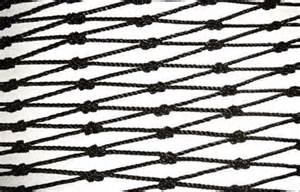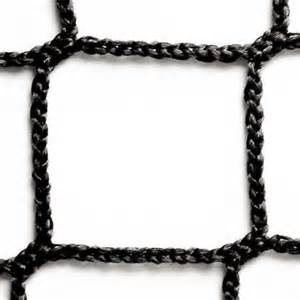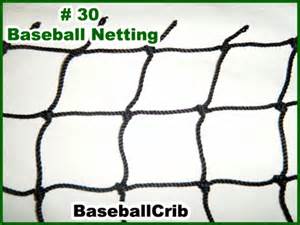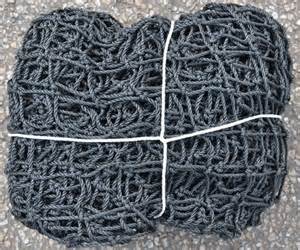Batting Cage Nets - Quality Only
Batting Cage Nets may at first seem rather out of place in a “How To” teaching site, but I’ve seen many well meaning and dedicated coaches attempt to build batting cages, only to scrap the project due to cover problems.
I’m going to give you a quick overview of Batting Cage, types, knots & etc. so you’ll be able to make an educated decision should you decide to build a batting cage or back stop.

Initial Quality Concerns:
1. Check to insure the netting is made of quality polyethylene or nylon.
2. Check to see how the netting is attached to the borders. If the netting is simply attached to the rope borders, it will most likely tear loose after a short period of time, which will leave gaps and create drooping of the netting.
A. Make sure the border rope is weaved into and through the netting creating a much stronger bond and the rope encompasses the entire net. Some netting will only have the rope along the top and bottom, maintaining the sides are left bare for attaching additional netting.
That may be true, but additional netting can be attached just as easily to a net totally roped. Insist on this because it gives you a much stronger net which holds its shape.

What Type Of Twine To Choose:
The twine used to construct batting cage netting, will either be made of Nylon or Polyethylene and your intended use of the cage will dictate which type you should choose.
Nylon netting provides the strongest netting against breakage and is by far the most durable cage netting, however there are two drawbacks.
A. Nylon netting absorbs water, which will cause rotting and shrinkage and could lose up to 20% of its strength. Therefore, Nylon netting should not be chosen for Outside Usage.
B. Nylon is very expensive. However, if cost is not a factor and the netting will be used indoors, nylon is by far the superior product.

Polyethylene netting will not break down, shrink or rot, in outdoor use as Nylon will. However, its initial break strength is not nearly as high as nylon.
My recommendation for the average coach would be to use the polyethylene netting as it’s plenty strong enough for youth baseball and cost much less than nylon. Even if I was only going to use it indoors, I’d still go with the Poly.
Twine is measured by thickness and the larger the number, the thicker the twine. This is extremely important to know because your buying netting for a particular purpose and you want to be sure you’re getting what you need. Here’s a general guide to net size and usage.
#12 Twine - Thinnest size to be used only for light recreational usage and is not recommended for batting cage netting, it’s too weak.
#18 Twine - Second smallest size and too small for batting cage usage.
#21 Twine - This size is capable of being used for batting cage netting, but is limited in strength and recommended for Only the youngest aged little league players.

#30 Twine - Size will accommodate players from Middle School down. It can be used by older players, but the increased abuse of harder hit baseballs will limit its usable life span.
#36 Twine - I would classify this size of netting as the “Normal” or Most effect sized netting. This size of netting is strong enough to withstand baseballs hit by High School aged players and is at the lower end, cost wise, of acceptable batting cage netting which will last. After all, we’re talking youth baseball here.
#42 Twine - This is regarded as a Commercial grade netting used by colleges and many pro teams.
#45 Twine - This netting is by far the strongest netting available for our intended use. It comes as Knotted or Unknotted, Square or Diamond hung.
#60 Twine - This is total over kill and actually bad netting for our purpose because of the excessive weight and lack of elasticity.
*** Beware *** This numbering system may be different for different manufactures’ so be sure to double check to be sure of exactly what you’re buying.
Shapes:
Netting comes in various styles, but the two major styles are Square or Diamond and each have their pros and cons.
Diamond-hung nets require less netting to make therefore reducing Cost. The net is designed to hang loosely over the batting cage frame, which allows the netting to spread the shock of the baseball strike across several meshes, which helps eliminate high wear spots.
Square-hung nets require more material to make, therefore Cost More than Diamond-hung nets. However, the net will hang much straighter on the cage frame, naturally conforming to the supports. Possibly the best qualities of the Square-hung net are they are easier to install and allow for better visibility than the Diamond hung.
What’s Really Important ?
Break Strength is a term you will hear bantered about when shopping for netting. This term is misused and has far too much emphasize placed on it. The term refers to how much tension a cross section of netting will withstand before Necking, which means being to bend.
This has Nothing to do with durability or strength as far as breaking. An example of Breaking Strength can easily be visualized in a tennis racket. The strings in a tennis racket are under tension, therefore break strength means the individual string will actually break into. This has nothing to do with batting cage netting.
Real Issues To Look For:
1. How well does the net hold up to weather conditions.
2. What size and weight is the netting?
3. How well does the twine resist abrasion?
4. How long will the netting hold its strength? 1 year? 5 years? 20 years?
5. How is the actual cage frame constructed?
I hope this crash course in baseball cage netting and the accompanying links below helps you in making a better informed decision when buying.
Batting Cage Nets To Baseball Diamond

New! Comments
Have your say about what you just read! Leave me a comment in the box below.